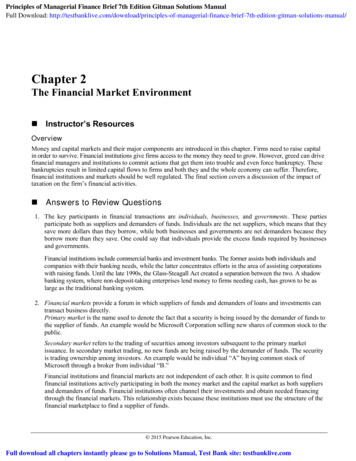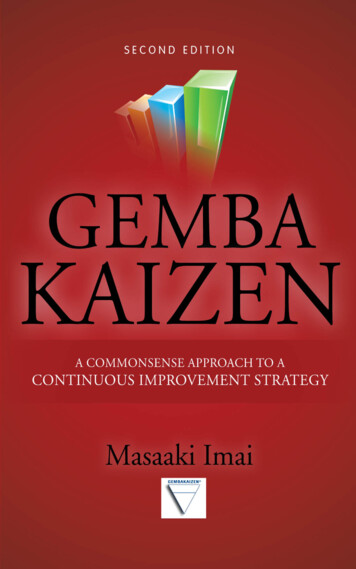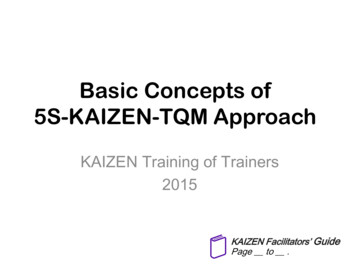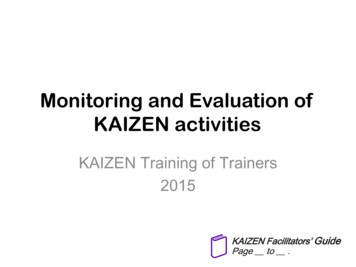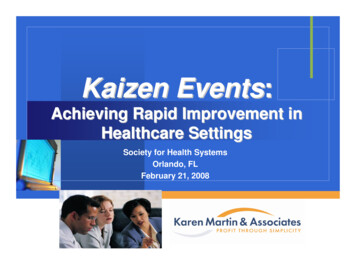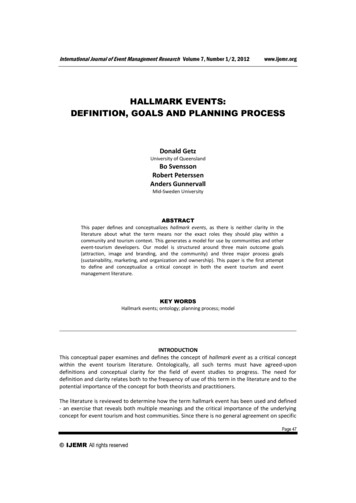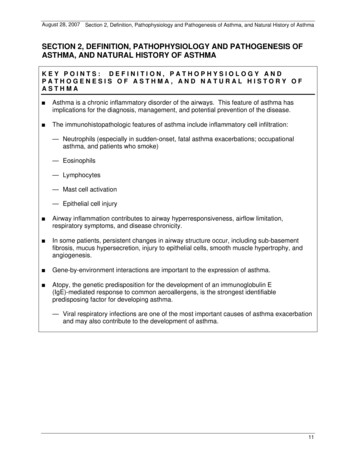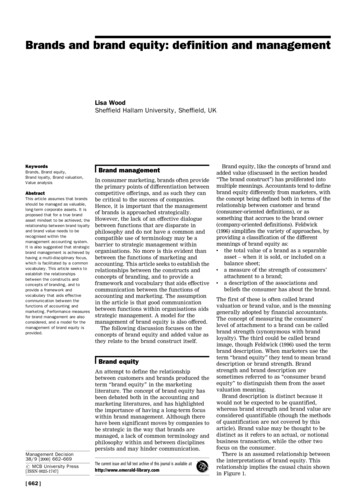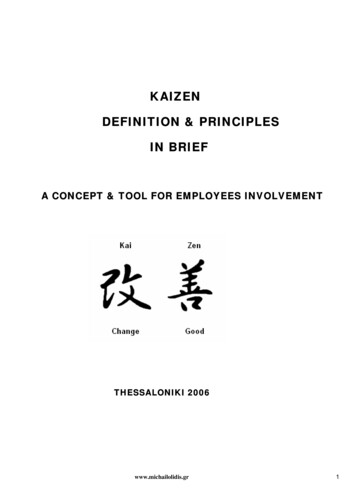
Transcription
KAIZENDEFINITION & PRINCIPLESIN BRIEFA CONCEPT & TOOL FOR EMPLOYEES INVOLVEMENTTHESSALONIKI 2006www.michailolidis.gr1
1. Definition and principles of KaizenIn the decade of 1980, management techniques focusing on employee involvement, andempowerment through teamwork approach and interactive communications and on improvingjob design were not new, but Japanese companies seemed to implement such techniquesmuch more effectively than others .The business lesson of the 1980’s was that Japanesefirms, in their quest for global competitiveness, demonstrated a greater commitment to thephilosophy of continuous improvement than Western companies did(1).For such a philosophythe Japanese used the term Kaizen.Kaizen means improvement, continuous improvement involving everyone in the organizationfrom top management, to managers then to supervisors, and to workers. In Japan, the conceptof Kaizen is so deeply engrained in the minds of both managers and workers that they often donot even realize they are thinking Kaizen as a customer-driven strategy for improvement(2).This philosophy assumes according Imai that ‘’our way of life – be it our working life, our sociallife or our home life – deserves to be constantly improved’’ (3).There is a lot of controversy in the literature as well as the industry as to what Kaizen signifies.Kaizen is a Japanese philosophy for process improvement that can be traced to the meaningof the Japanese words ‘Kai’ and ‘Zen’, which translate roughly into ‘to break apart andinvestigate’ and ‘to improve upon the existing situation’(4). The Kaizen Institute defines Kaizenas the Japanese term for continuous improvement. It is using common sense and is both arigorous, scientific method using statistical quality control and an adaptive framework oforganizational values and beliefs that keeps workers and management focused on zerodefects. It is a philosophy of never being satisfied with what was accomplished last week orlast year (5) ,(6) .Improvement begins with the admission that every organization has problems, which provideopportunities for change. It evolves around continuous improvement involving everyone in theorganization and largely depends on cross-functional teams that can be empowered tochallenge the status quo.www.michailolidis.gr2
The essence of Kaizen is that the peoplethat perform a certain task are the mostknowledgeableCustomer orientationTotal Quality controlRoboticsQC circlesSuggestion SystemAutomationDiscipline in the workplaceTPMconsequently,KambanQuality improvementJust in timeZero defectsSmall group activitiesProductivity improvementNew product developmentaboutbythatinvolvingtask;themandshowing confidence in their capabilities,ownership of the process is raised to itshighest level(7).In addition, the team effortencourages innovation and change and,by involving all layers of employees, theimaginary organizational walls disappearFigure 1:Κaizen s. From such a perspective, Kaizen is not only an approach to manufacturingcompetitiveness but also everybody's business, because its premise is based on the conceptthat every person has an interest in improvement. The premise of a Kaizen workshop is tomake people's jobs easier by taking them apart, studying them, and making improvements.The message is extended to everyone in the organization, and thus everyone is a contributor(8).So, when Kaizen for every individual could be an attitude for continuous improvement, t .The KaizenPhilosophyTeamsAs presented5Sby Imai ,Kaizenis an umbrellaDiscipline In theWorkplaceProductivityImprovemetntconceptProcess FocusthatembracesdifferentcontinuousFigure2: The kaizen constituentsactivities on an organizationas shownimprovementin Figure 1(9) .Also Kaizenconstituents arepresented on Figure 2www.michailolidis.gr3
According to James Womack in his book ‘’ The Machine That Changed the World ‘’ (1991),(10)with Kaizen, the job of improvement is never finished and the status quo is always challenged.Kaizen techniques became famous when Toyota used them to rise to world automotiveleadership. Rather than undertake large projects, Toyota's staff was encouraged to identifyproblems, no matter how small, trace their root causes, and implement all necessary solutions.Improvements through Kaizen have a process focus. Kaizen generates process-orientedthinking, is people-oriented, and is directed at people's efforts. Rather than identifyingemployees as the problem, Kaizen emphasizes that the process is the target and employeescan provide improvements by understanding how their jobs fit into the process and changingit.The companies that undertake a Kaizen philosophy place an emphasis on the processes - onthe 'how' of achieving the required results.A process emphasis goes beyond designingeffective processes; it requires the teams to understand why a process works, whether it canbe modified or replicated somewhere else in the company and how it can be improved. Table1 ,illustrates some of the major differences between a conventional and a process-emphasisapproach.Conventional approachProcess-emphasis approachEmployees are the problemThe process is the problemDoing my jobHelping to get things doneUnderstanding my jobKnowing how my job fits in the processMeasuring individualsMeasuring performanceChange the personChange the processCorrect errorsReduce variationWho made the error?What allowed tile error to occur?Table 2. 1: improvements through kaizen: a process focusThe starting point of a process-emphasis approach is to map the process in order tounderstand the flow of the product or service. To give more pictorial the difference betweenprocess and targets concepts lets have a look on two ancient man-activities in real life.Farming and hunting activities :On process approach (farming )the characteristics are :www.michailolidis.gr4
Land preparation including levelsRemoval of obstacles, stones and rocksSoil enrichmentWater managementPlantingWeed controlPest and disease controlComparisons and benchmarking with neighboring farmsMonitoring progress relative to each stepHarvestingΟn a target approach ( hunting ) the characteristics are:Hear or see possible preyIsolate a specific targetPrepare personal toolsApproach target with known skillsAim at first realizable opportunityMake second attempt if first failsRelax once successful until hungry.The effect on thinking of these two activities then is presented on the following table:Effects on ThinkingFarmingHunting-Long term-Short term-The process is king-The Individual is king-So enhance participation in the process-So enhance the empowerment of the-Weather affects output so poor yearsindividualunderstood-Weather should not affect output so a-Market share (amount of land that canbad year not acceptedbe developed) is paramount-Hunting-Growth comes from extra market shareparamount(more land) and improving the process-Acquisitions are another form of huntingskill(returnonoutings)-Growth from faster huntingTable 2 : effects on thinking: target vs process approachThe Japanese have been farmers for 50 years , so easily one can understand their devotionand discipline on continuous improvement way of thinking and living (11) .The implementationwww.michailolidis.gr5
of Kaizen principles has been viewed as one of the key factors to Japanese competitivesuccess. Kaizen then has emerged in the U.S. as a methodology leading to dramaticincreases in productivity by manufacturing companiesProcess quality improvement needs the use of specific tools and techniques to be introducedand supervisors and operators to be trained on. Appendix 2.1 contains examples of continuousimprovement tools, the ,so known as ‘9 Tools‘, such as : process flow charts, Pareto analysis ,run charts, data collection, histograms, scatter analysis,checklist ,a cause and effect diagram,control charts, that used by the teams to detect problems , facilitate processes and implementproposals(12) .The role of visual management as a concept, practice or tool is promoted in Kaizen throughindividuals or teams to help people identify problems or promote empowerment. The practiceof visual management involves the clear display of tangible objects (gembutsu), charts, lists,records of performance, so that both management and workers are continuously reminded ofall the elements that make the Visual controls make it easy for everyone to identify the state ofa normal or abnormal condition, thus providing operators and management visibility intoperformance (see Appendix2.2) Visual controls tracking performance should capture the teameffort rather than the individual. Visual controls usually lead to visual management, which canbe particularly efficient if it is used adequately to replace the bureaucratic monitoring systemsthat many companies employ in order to maintain control and attempt to prevent anything fromgoing wrong. Visual controls must be relevant, easy to understand by the people performingthe task being measured, and must emphasize proactive actions, rather than blaming ,so thevisual workplace will: (13). improve safety make critical information available at a glance gain immediate measurable results including: reduced floor space, decreased processtime and machine down time keep everyone informed of production schedules, daily attendance, inventory levels,etc. reduce search time by as much as 50% reduce inventory as much as 10% to 30% raise morale and on-time deliverywww.michailolidis.gr6
introduce techniques that will allow significant reductions in lead time (10-25%) build communication between shifts, work areas, and organization levels improve quality 10-20% .There are two elements that construct kaizen, improvement / change for the better andongoing / continuity. Lacking one of those elements would not be considered as kaizen. Forinstance, the expression of “business as usual” contains the element of continuity withoutimprovement. On the other hand, the expression of “breakthrough” contains the element ofchange or improvement without continuity. Kaizen contain both elements.Another key aspect of kaizen is that it is an on-going, never-ending improvement process. Asthe reader may already know, it is not too difficult to introduce something new into anorganization. The difficult part is, how tokeep it going and maintain the momentumonceithasbeenintroduced.Manycompanies have tried to introduce suchprojects as quality circles, reengineering,and lean production. While some of themhave been successful, most have failed tomake such a project a going concern. Forinstance,manyWesterncompaniesintroduced quality circles by involvingFigure 3: kaizen is everybody’s jobemployees but most companies havesimply given up the idea of quality circle activities by now as a way to improve quality, cut costand speed products to market.The message of the Kaizen philosophy is that not one single day should go by in the firmwithout some type of improvement being made in some process in the company. Kaizen iseveryone's job; it requires sophisticated problem-solving expertise as well as professional andengineering knowledge and involves people from different departments working together inteams to solve problems, as shown in Figure 3www.michailolidis.gr7
Kaizen deals with the management of change and is a methodology in the right direction toimprove manufacturing operations, on a continual and incremental basis following the rightsteps (14):-Establish a plan to change whatever needs to be improved,-Carry out changes on a small scale,-Observe the results, and-Evaluate the results and the process and determine what has been learned .The starting point for improvement is to recognize the need. So Kaizen principles emphasisproblem-awareness and provide clues to identifying problems. When identified, problems mustbe solved, so Kaizen is also a problem-solving process. But, most of all, Kaizen is amanagement philosophy that forces higher standards at all levels of the organization byencouraging continuous improvement in all processes. Professor Hitochi Kume of TokyoUniversity compared quality control in the West and Japan:’’ I think that while control in theWest aims at ‘controlling’ the quality and conformance to standards and specifications, thefeature of the Japanese approach centers around improving (Kaizen) quality. In other words,the Japanese approach is to do such Kaizen systematically and continually ‘‘(15). Kaizenapproach is based on the premise that there is no perfection in a process, because nostructure, product, or system ever achieves the ideal stage and where it can be improved byfurther reducing waste .2. Kaizen -The three pillars2.1The three pillarsAccording to M. Imai, a guru in these management philosophies and practices , the threepillars of kaizen are summarized as follows:1.housekeeping2.waste elimination3.standardizationandas he states , themanagement and employees must work together to fulfill therequirements for each category. Tο be ensured success on activities on those three pillarsthree factors have also to be taken account .www.michailolidis.gr8
1.visual management,2.the role of the supervisor,3.the importance of training and creating a learning organization.More analytically on each one pillar of Kaizen:2.1.1 HousekeepingThis is a process of managing the work place ,known as ‘’Gemba’’ (workplace ) in Japanese,for improvement purposes .Imai introduced the word ’’Gemba ‘’, which means ‘’real place’’,where value is added to the products or services before passing them to next process wherethey are formed(16).For proper housekeeping a valuable tool or methodology is used , the 5S methodology. Theterm “Five S” is derived from the first letters of Japanese words referred to five practicesleading to a clean and manageable work area: seiri (organization), seiton (tidiness), seiso(purity)
Kaizen then has emerged in the U.S. as a methodology leading to dramatic increases in productivity by manufacturing companies Process quality improvement needs the use of specific tools and techniques to be introduced and supervisors and operators to be trained on. Appendix 2.1 contains examples of continuous improvement tools, the ,so known as ‘9 Tools‘, such as : process flow charts .File Size: 330KBPage Count: 42

